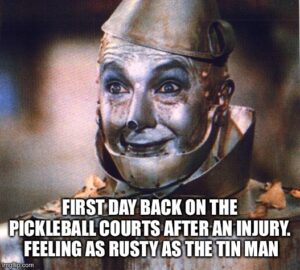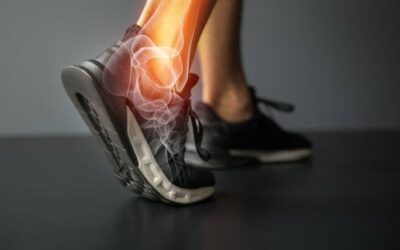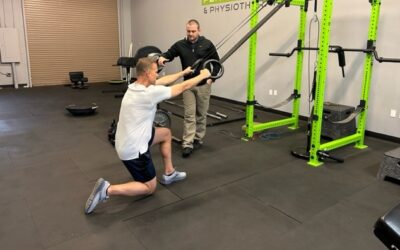
It’s fall everyone! Today’s the day! The sun is shining, the weather is cooling off, it’s time to play some pickleball, and the snowbirds are back in town!
*GASP*
It’s time to play some pickleball?!
You read that right, pickleball season is approaching, and the competition is coming back!
Don’t worry, you still have some time to prepare and/or take care of that injury you’ve been hoping would “just go away”.
But first, don’t let those pickleball injuries you thought would just go away get you down. We can help with that! You’re not alone. Many of your fellow pickleball players have suffered from similar injuries or are currently suffering from the same injury.
In today’s blog, we’re going to list a few of the most common pickleball injuries and provide some helpful advice on how to prepare for the upcoming season.
Here are a few of the most common pickleball injuries.
Number 1: “Pickleball Elbow”
Just like a tennis elbow and golfer’s elbow, a pickleball elbow is an overuse injury. The pain is felt along the outside of the elbow. This can be due to getting back into it too quickly, playing too many games in a row, or even due to compensation.
Yes, I said it, compensation.
I treated my first pickleballer of the season already! And, go figure, she has a pickleball elbow. And let me tell you, her elbow wasn’t the problem…
Upon further evaluation, she had weakness in her core, low back, and legs. She also had poor trunk mobility, leading her to compensate with her elbow. This eventually led to the pickleball elbow.
Like a golfer’s elbow, a pickleball elbow is an overuse injury. When you start a match, it hurts pretty bad until you get warmed up and then you think, “Hey, I’m feeling better. I got this”. Towards the end of a close game, that elbow pain comes back strong and you’re thinking “Oh my gosh, what did I do to myself?”.
The trick with pickleball elbow is appropriate rest and load, which can be a hard balance to find on your own.
Number 2: Achilles Tendonitis
The quick movements and explosive changes in direction that occur in pickleball can lead to Achilles tendonitis or calf/heel pain. Achilles tendonitis is very similar to pickleball elbow. They are both a tendonitis, which simply means inflammation or irritation of a tendon.
Just like pickleball elbow, this may be due to starting pickleball without much training or returning to pickleball after taking some time off (like taking the summer off because it’s too hot to go outside and all the indoor courts were taken).
Your body needs to be prepared for the activity it’s going to participate in.
Physical Therapy can help reintroduce these movements and activities to allow the body to adapt and prepare you to smash the competition on the courts.
Number 3: Ankle Sprain
You’ve probably done it.
You turn too quickly to get to a ball and you roll your ankle. Soon enough it’s swollen and strange shades of purple, blue, and green. It’s really hard to walk on and the swelling takes a while to go away. Once you can walk without pain or a limp, you think you’re ready to get back on the court.
You push off quickly to return the serve and boom, ankle pain. Now you’re sitting there thinking, “Why does my ankle still hurt?”.
You did what you knew how to do. You took time off, the swelling is down, and you can walk without pain; so what’s the problem? As I’m sure you know, walking is very different from running and quick change of directions.
Your ankle may be ready to tolerate all your daily walking, but it’s not quite ready to run and change directions.
Number 4: Knee Sprain
The mechanism of injury is very similar to an ankle sprain.
You might turn to change directions quickly and it leads to knee pain. There isn’t typically as much bruising as an ankle sprain, but it’s possible and you may suffer from swelling as well.
The recovery from a knee sprain is very similar to an ankle. You begin to move around normally and perform your daily activities without pain, so you think you’re ready to get back on the court.
Maybe not.
Making sure you’re training the movements and activities you’re going to perform in pickleball are key to your recovery.
But how do you know how much to do or how hard to push?
Number 5: Wrist Fracture
I’m sure you know someone who fell on the pickleball court and broke their wrist. Unfortunately, it’s much too common of a pickleball injury.
Physical therapy can help set you up with a balance training program to assist with improved static and dynamic balance. We can also assist you in developing a strength program.
Believe it or not, strengthening is a very important piece to balance. Because balance is dependent on the strength of your muscles, increased strength leads to improved balance and ultimately decreased fall risk. When you feel confident in your balance, you won’t take that extra second to decide if you should go for that ball.
The answer is yes, you should go for that ball and take the lead!
Number 6: Shoulder impingement
A common diagnosis leading to shoulder pain is shoulder impingement.
A vague explanation for shoulder impingement is a compression of tissues in the shoulder joint that causes pain. (For more info on shoulder impingement, go to our other most recent shoulder impingement blog). This may be due to poor mobility, decreased range of motion, or weakness. Don’t let your pain stop you from competing!
A Physical Therapist can help determine what is contributing to your shoulder pain and most importantly how to rehabilitate your shoulder and allow you to continue to play the sport you love.
Here are a few prevention tips for you to prevent pickleball injuries.
- Proper hydration
- Perform a dynamic warm-up that mimics the activities you will be performing
- Exercise regularly
- Appropriate recovery time
- See a Physical Therapist
- We can perform pickleball injury prevention screens, evaluate a current injury, or set you up with an appropriate at home program to assist with decreased injury risk.
In summary, the best thing you can do for any injury is ask for help. Come see a licensed Physical Therapist who specializes in athletes and active adults. Let us help you continue to compete!
Give us a call at (480) 452-9191 or reach out on our website to see how we can help you get back to beating your competition on the court!




